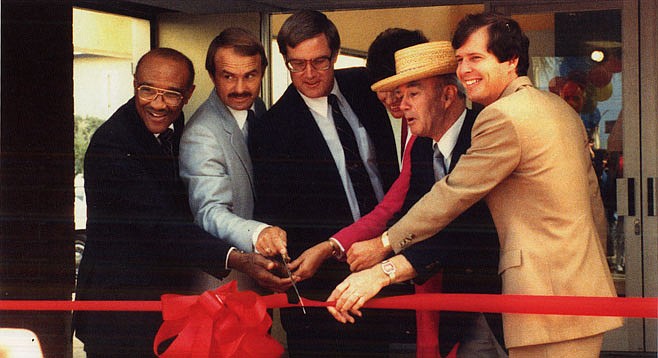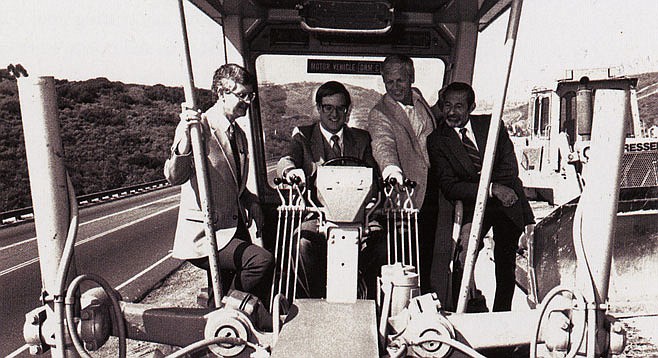 Facebook
Facebook
 X
X
 Instagram
Instagram
 TikTok
TikTok
 Youtube
Youtube

Chula Vista turned 100 this year. Along with holding celebrations, the city published a centennial book detailing the growth of San Diego County’s second-largest city. A popular adage maintains that history is written by the victors, and that’s how some Chula Vista residents feel about the book.

Jerry Thomas, longtime Chula Vista activist and a member of the Southwest Chula Vista Civic Association, said in a recent interview, “What upsets me is, the historian was absolutely wonderful, and a historian should not have his writing altered by politicians, particularly for political purposes…. Like you do with most books, you open it up in the middle, and it was one page after another of [county supervisor] Greg Cox and [former port commissioner] David Malcolm and [Chula Visa mayor] Cheryl [Cox] and all her cronies. I was totally outraged at how self-serving it was.… That was probably the lowest, most contemptible thing that they could have done to degrade the celebration of the city of Chula Vista.”
Chula Vista Centennial: A Century of People and Progress focuses on 1911 to 2011 and was written by former USD professor Steven Schoenherr. The city sells it for $40. Schoenherr volunteered his time to create this coffee-table book filled with lush moments of Chula Vista’s past. The prologue, which begins with the Kumeyaay, sets the stage for lemon trees to gradually give way to suburbs. Ten decades are covered in 215 pages, and the foreword is written by Mayor Cheryl Cox and Councilmember Pamela Bensoussan.
While critics have nothing but praise for the first three-quarters of the book, they believe the last few chapters skew or misrepresent the city’s history and appear to serve the campaigns of Supervisor Greg Cox and Councilmember Bensoussan. Both are scheduled to run for reelection in 2012.
Susan Watry, a 50-year resident and political activist, wrote in a recent letter to the editor of the Chula Vista Star-News, “When we got to the last two chapters it was obvious to us that the rumors were true. Cheryl Cox and Pamela Bensoussan had, indeed, hijacked our Centennial book and turned it into a re-election tool for Pam and a showcase for Cheryl’s insider cronies and family. David Malcolm has seven index entries, and none of them are about his conviction for conflict of interest when he was the Chula Vista Port Commissioner. Lest you had any doubt, Chula Vista is the city Greg Cox built — on 21 pages.”
In a follow-up interview, Watry gave examples of anecdotal material she believes consume valuable pages that might have been used to give a more complete picture of the city. She points to the picture of Bensoussan’s dog Sophie stuck in a tree, the paragraph about Greg Cox’s babysitter, and the paragraph about the prisoners who work for Cheryl Cox’s father cleaning up the regional park and who call him “boss.” “The last two sentences of the book sum it up,” Watry said. “Greg Cox is quoted in the next-to-last sentence and Cheryl Cox in the last sentence.”
One explanation for the composite writing can be found in the author-publisher agreement, obtained through a public records request, which names the city of Chula Vista as the publisher. The contract states, “The Publisher shall have the right to edit, package, publish.… [The publisher] will determine the quality and quantity of photographs and illustrations…and the Publisher determines the quality and quantity of front matter and back matter, introduction, preface, index.”
On the acknowledgment page, the author thanks the extensive “Committee of 100 Book Research Members” who assisted the author in gathering the history. Bensoussan and the Coxes are part of the committee; the Coxes’ daughter Emily is part of the “Book Outreach Team.”
Many say the book’s problems lie with what has been excluded as much as with what has been included. David Danciu, president of the civic organization Crossroads II, also praises the first part of the book. “I opened my copy, and like a time traveler, sailed through the decades of development, change, and growing pains…. But then the tempo changed….. Why did it appear that the history became about elected or running-for-election officials and their contributors and interests…. It almost appears that certain local residents involved in community activism were purposely omitted.”
In fact, Danciu presented the city council with Crossroad II’s version of civic history: “A Short History of Community Activism in Chula Vista — l970’s to Present.” The pamphlet, which was inspired by what was missing in the centennial book, details the community’s fight for public ownership of water, for controlled growth, for saving Friendship Park, among other battles.
Danciu questions, “Why does a book written for our 2011 centennial not have one picture of our sitting city council?” There are no indexed entries for Councilmember Patricia Aguilar and no pictures, although she was elected in 2010, and Councilmember Steve Castaneda has only three indexed entries and one picture, although he has served in Chula Vista since 2004.

By contrast, there are 14 indexed pages for developer Corky McMillin or the McMillin Companies, including three photographs of Corky. One of the pictures shows him on a tractor with former mayor Greg Cox, plowing down H Street to the new eastern developments.
In addition to detractors, the city’s centennial book has admirers. On the website PRWeb, the city has posted an article that includes book reviews by local luminaries Loren Nancarrow and Ken Kramer. Kramer says, “Anyone who knows and loves Chula Vista will find the centennial book to be a real treasure. From the days of citrus and celery to the World Champion Little Blue Bombers, its wonderfully researched stories and fascinating photographs are a proud and lasting tribute to the city.”
Sight unseen the book had appeal. The cost of the printing, $58,685, was sponsored by Chelsea Investment Corporation, the EastLake Company, the Corky McMillin Companies and McMillin Realty, Otay Ranch New Homes/JPB Development, Otay Ranch/Baldwin and Sons, and Otay Land Company.


Chula Vista turned 100 this year. Along with holding celebrations, the city published a centennial book detailing the growth of San Diego County’s second-largest city. A popular adage maintains that history is written by the victors, and that’s how some Chula Vista residents feel about the book.

Jerry Thomas, longtime Chula Vista activist and a member of the Southwest Chula Vista Civic Association, said in a recent interview, “What upsets me is, the historian was absolutely wonderful, and a historian should not have his writing altered by politicians, particularly for political purposes…. Like you do with most books, you open it up in the middle, and it was one page after another of [county supervisor] Greg Cox and [former port commissioner] David Malcolm and [Chula Visa mayor] Cheryl [Cox] and all her cronies. I was totally outraged at how self-serving it was.… That was probably the lowest, most contemptible thing that they could have done to degrade the celebration of the city of Chula Vista.”
Chula Vista Centennial: A Century of People and Progress focuses on 1911 to 2011 and was written by former USD professor Steven Schoenherr. The city sells it for $40. Schoenherr volunteered his time to create this coffee-table book filled with lush moments of Chula Vista’s past. The prologue, which begins with the Kumeyaay, sets the stage for lemon trees to gradually give way to suburbs. Ten decades are covered in 215 pages, and the foreword is written by Mayor Cheryl Cox and Councilmember Pamela Bensoussan.
While critics have nothing but praise for the first three-quarters of the book, they believe the last few chapters skew or misrepresent the city’s history and appear to serve the campaigns of Supervisor Greg Cox and Councilmember Bensoussan. Both are scheduled to run for reelection in 2012.
Susan Watry, a 50-year resident and political activist, wrote in a recent letter to the editor of the Chula Vista Star-News, “When we got to the last two chapters it was obvious to us that the rumors were true. Cheryl Cox and Pamela Bensoussan had, indeed, hijacked our Centennial book and turned it into a re-election tool for Pam and a showcase for Cheryl’s insider cronies and family. David Malcolm has seven index entries, and none of them are about his conviction for conflict of interest when he was the Chula Vista Port Commissioner. Lest you had any doubt, Chula Vista is the city Greg Cox built — on 21 pages.”
In a follow-up interview, Watry gave examples of anecdotal material she believes consume valuable pages that might have been used to give a more complete picture of the city. She points to the picture of Bensoussan’s dog Sophie stuck in a tree, the paragraph about Greg Cox’s babysitter, and the paragraph about the prisoners who work for Cheryl Cox’s father cleaning up the regional park and who call him “boss.” “The last two sentences of the book sum it up,” Watry said. “Greg Cox is quoted in the next-to-last sentence and Cheryl Cox in the last sentence.”
One explanation for the composite writing can be found in the author-publisher agreement, obtained through a public records request, which names the city of Chula Vista as the publisher. The contract states, “The Publisher shall have the right to edit, package, publish.… [The publisher] will determine the quality and quantity of photographs and illustrations…and the Publisher determines the quality and quantity of front matter and back matter, introduction, preface, index.”
On the acknowledgment page, the author thanks the extensive “Committee of 100 Book Research Members” who assisted the author in gathering the history. Bensoussan and the Coxes are part of the committee; the Coxes’ daughter Emily is part of the “Book Outreach Team.”
Many say the book’s problems lie with what has been excluded as much as with what has been included. David Danciu, president of the civic organization Crossroads II, also praises the first part of the book. “I opened my copy, and like a time traveler, sailed through the decades of development, change, and growing pains…. But then the tempo changed….. Why did it appear that the history became about elected or running-for-election officials and their contributors and interests…. It almost appears that certain local residents involved in community activism were purposely omitted.”
In fact, Danciu presented the city council with Crossroad II’s version of civic history: “A Short History of Community Activism in Chula Vista — l970’s to Present.” The pamphlet, which was inspired by what was missing in the centennial book, details the community’s fight for public ownership of water, for controlled growth, for saving Friendship Park, among other battles.
Danciu questions, “Why does a book written for our 2011 centennial not have one picture of our sitting city council?” There are no indexed entries for Councilmember Patricia Aguilar and no pictures, although she was elected in 2010, and Councilmember Steve Castaneda has only three indexed entries and one picture, although he has served in Chula Vista since 2004.

By contrast, there are 14 indexed pages for developer Corky McMillin or the McMillin Companies, including three photographs of Corky. One of the pictures shows him on a tractor with former mayor Greg Cox, plowing down H Street to the new eastern developments.
In addition to detractors, the city’s centennial book has admirers. On the website PRWeb, the city has posted an article that includes book reviews by local luminaries Loren Nancarrow and Ken Kramer. Kramer says, “Anyone who knows and loves Chula Vista will find the centennial book to be a real treasure. From the days of citrus and celery to the World Champion Little Blue Bombers, its wonderfully researched stories and fascinating photographs are a proud and lasting tribute to the city.”
Sight unseen the book had appeal. The cost of the printing, $58,685, was sponsored by Chelsea Investment Corporation, the EastLake Company, the Corky McMillin Companies and McMillin Realty, Otay Ranch New Homes/JPB Development, Otay Ranch/Baldwin and Sons, and Otay Land Company.
Comments